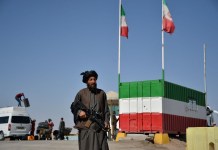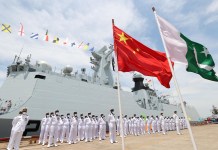A Saudi push to become a major natural gas player is as much about diversifying the kingdom’s domestic consumption and export mix as it is about taking advantage of harsh US economic sanctions against Iran designed to force a change of the Islamic republic’s policy, if not its regime.
Saudi Arabia scored an initial success with the sale of its first Liquified Natural Gas (LNG) cargo in Singapore, the trading hub for Asia and the Pacific, the world’s largest LNG market.
The sale speaks to the ambitions of Saudi Arabia’s national oil company, Aramco, that seeks to become a major gas player by partnering with producers across the globe, including in the Russian Arctic, and developing its own reserves.
Aramco expects the partnerships to position it as major marketer and trader, primarily in the spot and short-term markets.
An Aramco delegation visited Pakistan earlier this month to discuss gas sales as a way of addressing the South Asian country’s energy shortage as it opens its multiple gas fields to foreign investors.
At the same time, Saudi Arabia is looking to become a gas exporter in its own right in the next five to six years after recently discovering major reserves in the Red Sea.
Saudi Energy Minister Khalid al-Falih said earlier this month that the kingdom was already in discussion with other Gulf states about building natural gas pipelines and would soon be commissioning feasibility studies.
Those discussions are certain not to include Qatar and Iran, two of the region and the world’s foremost producers and the kingdom’s primary regional bete noirs.
If anything, the Saudi move is not only part of its longer-term efforts to reduce its dependence on oil exports and diversify its economy but also an attempt to take advantage of the fact that Iran is severely hampered by the Trump administration’s ‘maximum pressure’ campaign against it.
The administration said earlier this month that it intended to reduce Iranian energy exports to zero by cancelling waivers it issued to eight buyers, including China, India, Turkey, Japan and South Korea.
The waivers granted the eight countries exemptions to sanctions imposed last year after the United States withdrew from the 2015 international agreement that curbed Iran’s nuclear program.
Similarly, with the development of Saudi gas exports and sales also intended to chip away at Qatar’s market share, the Gulf state is not an option.
Qatar’s diversification of its exports was a key factor in its ability to so far fend off a 23-month old Saudi-UAE-led economic and diplomatic boycott that, like in the case of Iran, is designed to force it to change its policies.
The two sides’ entrenched positions offer no prospect of a resolution of the dispute any time soon. Saudi long-term gas ambitions could have shorter-term consequences for its regional policies, particularly with regard to Iran.
The kingdom, perceived to be a proponent of regime change in Tehran, may prefer a substantial weakening of the Iranian government that keeps it contained and struggling to make ends meet, rather than the rise of leadership acceptable to the West that would be allowed to quickly regain its place in global energy markets.
Striving for regime collapse rather than regime change would also allow Saudi Arabia to dampen prospects for Iran’s Indian-backed port of Chabahar, a mere 70 kilometres down the Arabian Sea coast from Gwadar, the Chinese-supported port in Pakistani Balochistan.
Saudi Arabia has pledged to build a US$10 billion refinery in Gwadar. Saudi plans to develop its gas industry suggest that the kingdom needs a decade to realize them.
Aramco chief executive Amin Nasser said he expected US$150 billion to be invested in the Saudi gas sector over the next ten years. Mr. Nasser envisioned gas production increasing from 14 billion standard cubic feet to 23 billion by 2030.
“We are looking to shift from only satisfying our utility industry in the kingdom, which will happen especially with the increase in renewable and nuclear to be an exporter of gas and gas products,” Mr. Nasser said.
“Aramco’s international gas team has been given an open platform to look at gas acquisitions along the whole supply chain. They have been given significant financial firepower – in the billions of dollars,” he added.
The kingdom has expressed an interest in acquiring a 30 percent stake in Russia’s Novatek Arctic LNG project.
Access to the project’s gas would allow Saudi Arabia to negotiate long-term deals and/or sell cargoes on the spot market or increase domestic supply.
Saudi Arabia is also looking to buy natural gas assets in the United States.
A Saudi-Russian deal in the Arctic would likely not only enhance the kingdom’s position but also bring Saudi Arabia, a member of OPEC, and Russia, which is not formally part of the cartel, closer together in their joint management of global oil supplies.
In a world of rising economic nationalism, Saudi gas ambitions are not being universally welcomed. While there is little doubt that the Trump administration will look favourably at Saudi investment, some analysts are raising red flags.
Said Jude Clemente of JTC Energy Research Associates: “We simply cannot hand the quickly globalizing (via LNG) gas market to more risky exporters that often have political goals that are contrary to ours (to put it politely).”
James M. Dorsey is a senior fellow at Nanyang Technological University’s S. Rajaratnam School of International Studies,




